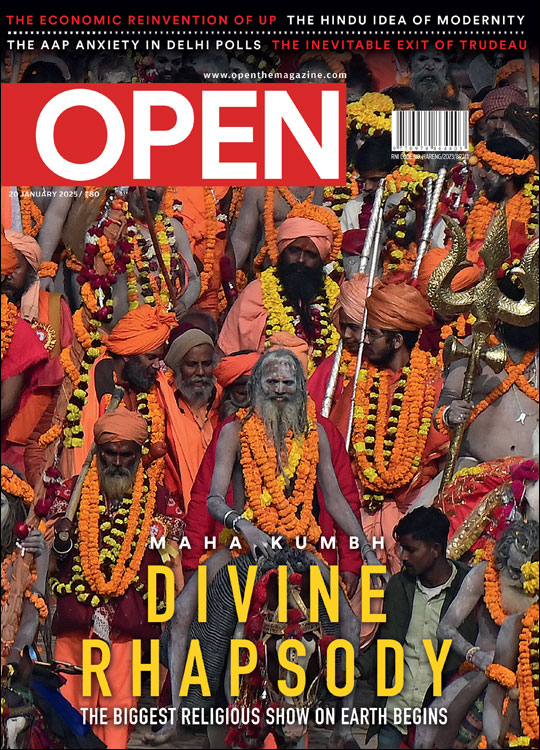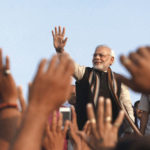Aggression of the ascetic
Deconstructing Modi’s semiotic war: Is it the end of Nehruvian India?
 Shiv Visvanathan
Shiv Visvanathan
 Shiv Visvanathan
Shiv Visvanathan
 |
15 May, 2014
|
15 May, 2014
/wp-content/uploads/2015/11/Open-Essay-Ascetic.jpg)
Deconstructing Modi’s semiotic war: Is it the end of Nehruvian India?
I come from a family of scientists who are as Nehruvian as you can imagine. For them, Nehru was a metaphor, a way of life, an intellectual style that was both cosmopolitan and aesthetic. Over the past two decades, one saw attempts to revive and re-articulate the Nehruvian Model. These efforts remained elitist and cosmetic. In reviving Nehru, they did not reinvent him. They created a nostalgia, at most a set of table manners as a form of political correctness. But the real death-blow to the Nehruvian idea came in Amethi this election as Modi stormed the fiefdom to campaign for Smriti Irani. Nehruvianism died a natural death as his epigone oozed mediocrity, confused family and nation, and forgot the axiomatic principles of its perspective. But that was the self-inflicted part of it. India has also seen a symbolic war that has destroyed the Nehruvian imagination and regime. And this we need to understand.
In writing history, it is the taken-for-granted we often forget. Modi’s semiotic war does not begin with Modi, it begins with the RSS. There is a tendency to be paranoid about the Sangh but deny it as anachronistic or tragicomic. The RSS is a powerful machine, and to achieve its aims, it realised the BJP had to achieve power at the Centre. For this, it was even ready to spring-clean the BJP of its old stalwarts. It also needed a man with the mindset of a pracharak who would magnify the RSS view to form the nation’s imagination. This required not the logic of size, which could be inflationary, but the logic of scale. One had to rebuild the imagination layer by layer and word by word.
Think of Narendra Modi. A dour, ascetic, almost colourless man, a chaiwala dressed in a dull white. He is the Eliza Doolittle of the RSS. Modi, 30 years ago, reminds me of the little drawings and cut-out dolls my sisters used to have. There were bare outlines to which one could add any costume; colour it, build on it, transform it. The rules were simple but the possibilities infinite.
Think of the first image of the man. He exudes aggression. He is a nukkad hero, angry with history and Delhi. He feels history, official history, has been unfair to Gujarat, and that Delhi is merely a secret code of exclusion that makes Central power the preserve of the Nehru-Gandhis. Modi is a colourless soul who needs a touch of colour, of style. He has to be rescued from drabness and his dismal science of politics. Colour him literally. His kurta blossoms as peach, light green; his gamcha is now an angavastram, crafted for the symbols of style and leadership. His bare head holds a turban, dyed red, spectacular and ritually deep, with a touch of the primordial. Now, one must manicure the man. The beard is trimmed, the receding hair fights a valiant and victorious battle. A set of waistcoats and Murari Bapu sleeves completes our designer doll. Till now it is a silent movie. One now needs language—both words and body language.
Everyone knows a bully is a temporary cameo. Bullying works only in some contexts, and one then realises a leader is more than a bully. Leadership allows for a bigger canvas. This leader internalises every step. The bluster leads to silence, to a habit of listening. Silence sustained becomes an act of patience, a virtue. He still needs a new vocabulary, something that goes beyond the repetitiveness of riots, of accusation, denial and counter-accusation. The contentious history of the 2002 riots and the redundancy around it has to yield to a different narrative, one that opens out to India’s middle-class like a new promissory note, yet signals a new social contract for minorities.
Development becomes the new ritual of proactive citizenship. It was a secular, technocratic World Bank concept but could also be used as a politically playful dialectic. Thus, one could have the Gujarat or Kerala model of development. On an optimistic day, even the Bihar model. Modi used the halo of development as a disciplinary technocratic term, and then hijacked it politically. Development was now a politician’s game, which economists could join as knight-errants or consultants, secondary characters in the development battle. It was desperately seductive, and the Bhagwatis, Panagariyas, Sens, Nick Sterns and our local pack of social scientists joined in, splitting indices in a ritual reminiscent of the battle over the poverty line after the Green Revolution. Development was now a video game, an object of fixation like PlayStation or X-Box.
You corner a word and create a turf, a set of rituals, and then outsource it. It is now your game. You could create a new civics out of it. Add a variant called Governance, and you elicit a Pavlovian drool. With two words, you have grabbed the high moral ground; you have created a new discourse that all the volumes of EPW cannot drown.
Modi is now Mr Development. It is a conceptual coup that combines a word and a world with brilliance.
Development also performs a few other magical functions. It erases the past and turns one forward-looking; demand for development is a demand for a better future. It erases memory, whether it is a tribal’s past or a Muslim’s view of a land choked in the agony of genocide. Now the past is seen as hypochondria. It is your past and therefore parochial. In a bid to escape the past, Modi invites Muslims to the fair land of development. This is the new civics of citizenship, and erasure, its rite of initiation. It works not so much on minorities but on his constituency— the new middle-class.
Modi and the RSS were shrewd enough to grasp that to create Modi as a leader, he had to be co-produced; that is, mutually recreated along with his constituency— the new middle-class. This class was not confined to the old bureaucratic class of socialism with a mentality as wide as a ration card. It stemmed from consumerism, desire and entrepreneurship, and its origin owed more to Ambani than Nehru. It was a class proud of money-making and ownership of shares as an intrinsic part of citizenship. Aspirational and mobile, it thought beyond caste and sought to create an urbane image of success. While embedded in tradition, it clutched at certain symbols on the way to modernity, like Linus and his blanket. It adored technology and doted on the nation state. It loved Indian culture as a spectacle and was unapologetic about religion. It was tired of being laughed at by secular intellectuals, and Modi became a champion of this new middle-class. He embraced this majoritarian Hinduism by giving it a consumerist veneer. By linking it to the nation state, he literally created a new political project. Three key terms—‘middle-class’, ‘nation state’ and ‘development’—would provide the nodes of his politics. Ready with costumes and a new vocabulary, our actor now had to initiate the new costume ball.
The target: Delhi. The object: the Nehru-Gandhi dynasty. The project: the de-legitimisation of the UPA regime.
One begins tentatively with five-finger exercises. Little forays. Little acts of sniping. One adds to the adrenalin as the audience watches. Gujarat has to be built as the New Paradise. The Congress cannot invoke UPA I, but UPA II has to challenge the promise of Gujarat. A developmental contest begins, and Modi inaugurates its Olympics, each indicator prized like a gold medal. It was a brilliant move. Gujarat’s entrepreneurial successes, its urbanisation experience, its spectacular recovery from the Bhuj earthquake were all highlighted, with Modi orchestrating the show. It was a symbolic battle of numbers, and Modi could piously add that not a single riot had taken place since 2002. Gujarat, the new cornucopia, was contrasted to Delhi. Now Delhi as a construct had to fall symbolically.
For Modi, Delhi was always the Delhi of the Mughals and Nehru-Gandhis, of outsiders who had appropriated history and built a false iconography. Delhi had undermined democracy by undermining federalism. Many states could create alternative societies if Delhi let them; some had already seceded without the Centre knowing it. Supine, Delhi had also failed as a guarantor of security. It had little vision of India as a global power.
Vertebral Modi, ready to take charge of an absentee State called Delhi, would tie the ignored nationalist history of Patel, Vivekananda and Ambedkar to an India of the future. To achieve this, India had to exorcise Delhi of the dynasty.
Exorcisms and openings were to follow. It was, however, a waiting game, full of middle moves, each creating a grid of expectations. India had to be trained to think across a semiotic grid. Modi realised that the opposition ‘Gujarat versus Delhi’ was not enough. He had to shrink criticism, reduce the role of opponents. Criticism was read on the insider-outsider grid, as informal sedition stemming from Delhi intellectuals, the outsiders, the old English-speaking elite. Gujaratis knew better. Second, he had to create a new mentality as a confidence-building measure. Gujarat could receive justice from history only if it asserted itself and narrated its achievements. From its asmita to its economics, it became the antithesis of Delhi.
Yet, symbolism, to be complete, needed characters. Delhi was populated by puppets like Manmohan and Rahul. Their denigration was his next act semiotic destruction. It was an act of baiting and bludgeoning that rendered the Congress effete and its leaders impotent. Of course, Modi had moral luck as his opponents stumbled from scam to scam—their handling of which hurt them more than the scandals themselves. With ‘governance’ becoming a hallowed term, the moral emptiness of the Congress was not difficult to demonstrate. What had to be fastened to its sticking place was Manmohan’s impotence.
Let us look at Manmohan symbolically. The UPA I was legend and he was seen by many as the economist-hero, literally a philosopher king, a man who put his money where his mouth was. India was proud of its academic Prime Minister. Brahminic India waved him like a flag. One had to deflate this, do what a wag called ‘a Churchill’ on him, portraying him, as Britain’s PM had described Attlee, as ‘a modest man with a lot to be modest about’. By UPA II, Manmohan was literally that. His was a goodness that was correct, functional and clerical. Where square pegs had to fit square holes, the Manmohan regime had everything in place. Yet, when things turned erratic, his goodness, the quiet way he adjusted, proved inadequate. It could not cope with epic corruption under the regime’s watch. Manmohan’s goodness became autistic, regressing to a silence that suited Modi, who treated him with contempt.
But Manmohan the functionary was easy to neutralise. The real target was the Prince Charming of the regime, the modernist as boy-scout—Rahul Gandhi.
By UPA II, India had a new generation with no memory of either the Freedom Movement or the Emergency. It was an aspirational generation, globalised and upwardly mobile, open to a new symbolic India of the Information Revolution. To a generation that had microchips as genes, Rahul lacked cybercool. Worse, he treated politics as an avocation, projected an absentmindedness that was disconcerting. He was a successor who acted as third in command. He was almost echolalic in speech, talking of his ‘mummy’ and ‘nani’ when a nation expected assertiveness. For the semiotically hungry Modi, he was a perfect target.
The play of opposites was fascinating. Modi was focused aggression, while Rahul was quiet reticence. Modi was aspirational, while Rahul recited his family genealogy like a BA certificate. Modi gloated over performance, while Rahul signalled empty promise. Modi offered speed, while Rahul signified delay. Modi was inventive, Rahul correct. Modi was responsive, even as Rahul’s learning curve stayed flat. Modi screamed for attention, Rahul was absence personified. Modi summoned Patel, Vivekananda, Savarkar, Ambedkar and Vajpayee as if he had a full-fledged pantheon of nationalist heroes working for him, while Rahul’s language was simplistic, his invocations limited to family names. One suggested an epic, or at least a soap opera full of myth, the other barely survived as a limerick, too relaxed to convey even a Haiku-like tension.
The drama of contrasts became an exaggeration of opposites. Modi may have been an acquired taste, but Middle India was making him a habit, like tea. He had the right flavour, the right intensity, a local Wagh Bakri ready to be an orange pekoe—the right brew ready for the politics of the time.
Yet, Modi was not ready as yet. He had to pass the institutional test, obtain clearances from the Nanavati Commission and SIT. Time slowed symbolically for Modi, but his tactics worked. He realised that dissent was entropic and as critique tended to burn out quickly. It was a waiting game, but wait he could, like a crafty Odysseus, while secular battalions exhausted their script. As memory faded or turned contentiously repetitive, Gujarat signalled a need to move on. The SIT report sanitised him further. With civil society in disarray, Modi was ready for the final battle.
The battlefield had to change. The ‘Gujarat versus Delhi’ story was too parochial. The war had to be grander. Now it was an idea of India, not just an India of ideas. A new, aggressive idea of India—a match for China, proud to be at Davos—had to be articulated. This needed a mix of symbols both traditional and modern, Swadeshi and technocratic. Problem-solving had to have a touch of machismo. And our boundaries, like our integrity, had to be immaculately clear. By then Brookings and the World Bank had hailed him as the prophet of governance. The Congress, in contrast, sounded dysfunctional.
One needed that last touch of ruthlessness, a clearing out of the stables only the RSS could achieve. This regime was not to be a gathering of yesterday’s heroes. The RSS knew this was its sole chance. This would not be the regime of a Vajpayee who needed a stabilising double in Advani. Unlike Vajpayee’s inclusive magic, this was science, a semiotic war to put a new regime in place for the next few decades. This was not a battle for popularity, but survival. If the future was a scythe, it had to behead people from both sides. The future was Modi, the RSS and India. No other force was relevant. The semiotic machine had to strike clean. Modi was to be campaign manager and party supremo. The rest did not count. It was clear cut, this RSS decision. The election war had an economy to it.
If a week is a long time in politics, 10 years can feel like compressed time. In his capture of symbols, Modi has been ruthless. He has captured history, development and a middle-class imagination in 10 years. As a spectacle, he is impressive. Television’s idolatry of him is awesome. He is seen as the exemplar of his own paradigm. Replaying Patel, squashing Nehru’s epigone, and creating a new chapter of history—but as part of the subconscious. The dramas, though, are of a different order. As Nehruvians shrink, ‘Patel’ arises as a grand archetypal statue, the legend of Indian politics. Remember, small victories will not do. One must pulverise the Congress. Numbers must speak, uttering the epic victory of Modi.
As the Modi juggernaut reaches Lutyens’ Delhi, one is still left with many questions. How much of India will be Nehruvian, how much Modiesque? Will the RSS, like the CPM, tamper with society? What kind of role will civil society have? Will the State and RSS crush dissent? Will the marginalised have to accept a majoritarian consensus? What is swadesism in a ‘Modified’ society? Will it be a form of technocratic fundamentalism? These are not easy questions to answer, and as one who belongs to the opposition, one must ensure that Modi does not answer them in a facile manner. Democracy as trusteeship cannot be left to Modi alone. This much an opposition should gracefully and forcefully promise to uphold.

/wp-content/uploads/2025/01/Cover_Kumbh.jpg)











More Columns
The lament of a blue-suited social media platform Chindu Sreedharan
Pixxel launches India’s first private commercial satellite constellation V Shoba
What does the launch of a new political party with radical background mean for Punjab? Rahul Pandita